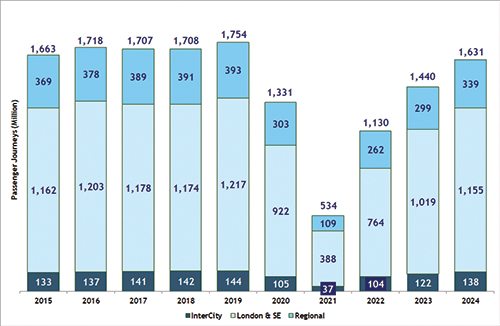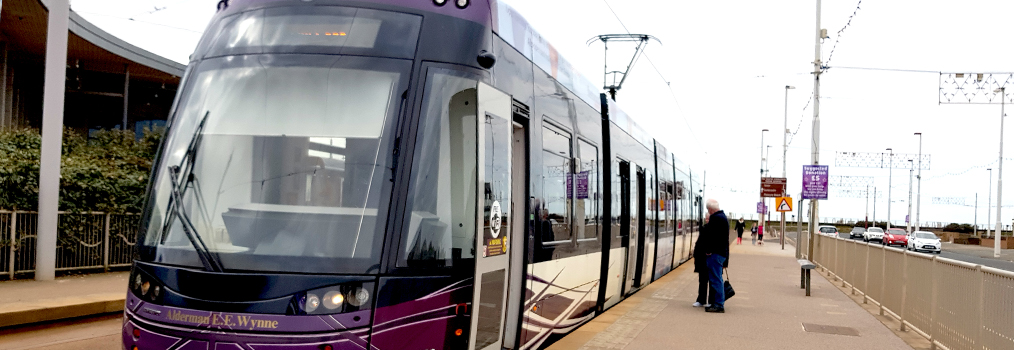Rail patronage has a spring in its step
InterCity and Regional Franchises drive growth, but revenue yields remain depressed
Demand growth in the British rail industry continued in the spring quarter, though the pace of recovery slowed again: non Elizabeth Line passenger numbers were 5.9 per cent higher than the same quarter in 2023, reaching a new post lockdown high. Including traffic on the recently opened line, growth was 7.1 per cent.

Overall, demand rose to 96.5 per cent of pre-Covid levels, according to National Rail Trends statistics, published by the Office of Rail and Road (ORR). However, without the Elizabeth Line, the recovery was limited to 85.5 per cent.
The provisional figures cover the first quarter of fiscal year 2024/25, finishing at the end of June: across the network, 419.9m passenger journeys were made during the twelve-week period, up from 392.0m in 2023. Between them, they covered 15.9 billion passenger kilometres, 2.5 per cent up, and paid a total of £2,824.4m in fares, 10.5 per cent more than in 2023.
Looking at demand by ticket type, advance tickets were up by 7.6 per cent, taking sales 57.4 per cent higher than before the pandemic. Anytime peak and off-peak fares were up by 6.3 and 9.3 per cent respectively, leaving them 14.6 per cent and 28.1 per cent ahead of the pre-Covid figure. Season ticket holders made 4.8 per cent more journeys than last year, but the 51.8 million total remained 63.4 per cent below the 2019 figure.
Excluding the Elizabeth Line, services in London and South East moved ahead by 4.6 per cent during the quarter, but this meant that it was the slowest growing sector. Between them, the operators carried 237.0m passengers in the twelve weeks, but remained 17.7 per cent below 2019. Growth was much slower than in previous quarters, with South Eastern leading the pack with 7.1 per cent, followed by West Midlands Trains (6.7 per cent) and GTR on 5.7 per cent. c2c saw a patronage fall of 1.3 per cent.
The Elizabeth Line carried 59.0 million passengers in its eighth full quarter of operation, 15.6 per cent up in the year, meaning that the line accounted for 14.1 per cent of the national network’s patronage in the April to June quarter, second only to GTR’s 17.2 per cent.
The long-distance InterCity sector saw demand increase by 6.2 per cent compared with 2023, leaving passenger numbers just 2.5 per cent short of 2019 levels. Cross Country saw the largest growth, on 14.9 per cent, 17.4 per cent below pre-pandemic levels. They were followed by Avanti West Coast on 7.2 per cent, but still 12.8 per cent down from 2019. EMR grew by 7.1 per cent, taking passenger numbers 15.3 per cent above pre-pandemic levels. GWR advanced by 3.8 per cent to 85.7 per cent of pre-Covid patronage, handicapped in part by the loss of Thames Valley suburban passengers to the Elizabeth Line since 2022. LNER recovered from the previous quarter’s fall in passenger numbers, recording growth of 3.1 per cent on the quarter, taking demand to 14.3 per cent ahead of its 2019 numbers. The newly nationalised Caledonian Sleeper operation saw a fall of 4.2 per cent, taking the business to 19.8 per cent short of previous highs.
Amongst the regional franchises, total patronage was 9.5 per cent up on 2023 but remained 11.9 per cent below 2019 levels. Amongst individual TOCs, TfW saw the strongest recovery, growing passenger numbers by 27.2 per cent during the quarter, reducing the shortfall against their 2019 figure to 7.9 per cent. TransPennine came next, advancing by 18.4 per cent, but still 18.8 per cent short of its 2019 figures. Scotrail grew by 10.8 per cent, 9.6 per cent short of pre-Covid levels. Merseyrail saw growth of 5.0 per cent but demand remained 32.5 per cent down on 2019. Northern saw a rise of 4.7 per cent in passenger journeys, leaving a shortfall of 18.2 per cent.
Amongst the non-franchised operators, First’s operations at Hull Trains and Lumo each saw growth of over eight per cent. Hull Trains exceeded their 2019 number by over 38 per cent. East Coast rivals Grand Central saw numbers fall back by 2.3 per cent during the quarter, but stayed almost 23 per cent ahead of their pre-Covid patronage. Still suffering from competition from the Elizabeth Line, Heathrow Express saw numbers slip by 12.3 per cent in the quarter. This left patronage on the premium route 31 per cent down on previous peaks.
Rolling year figures
The national totals for the twelve months ended 30 June show that, compared with the last pre-Covid year of 2018/19, the number of passenger journeys was seven per cent lower at 1,639.9 million. However, excluding the Elizabeth Line, passenger numbers remained 17.5 per cent short of the 2019 figure. Passenger kilometres travelled were 11.7 per cent lower at 59.6 billion, whilst passenger revenue saw a shortfall of 5.4 per cent at £9,800.6 million.
As in previous quarters, performance varied between the sectors. Passenger journeys were still 20.4 per cent below 2019 levels in London and South East but moved to within 13.9 per cent on the regional networks and 4.5 per cent on the InterCity routes.
Comment
It was inevitable that, as passenger numbers came nearer to full recovery from Covid, the rate of growth would slow, and we can see this clearly in the figures for this quarter and indeed the last one. Even so, the percentages are at the upper end of the sort of quarterly growth achieved in earlier, happier days.
This all took place against slightly improving economic backdrop, though interest rates remained high by post-2010 standards and consumer spending was still depressed: it was hardly the background to a boom in demand for transport.
More double-digit growth took place on the Elizabeth Line during the spring, prompting the order for additional rolling stock that kept Alstom’s Derby factory open. Patronage grew by almost a quarter during the spring to reach 59m, giving the line an annual total of 228 million, more 10 per cent above the original forecast. London Overground’s growth was more modest at 1.4 per cent, bringing the total to 46.2m, just 1.4 per cent below the pre-pandemic figure. Looking at the rolling year figures, the suburban and orbital routes carried 182.0m journeys – within 2.4 per cent of the 186.5m figure reached before Covid. Between them, the two TfL concessions accounted for a quarter of national patronage during 2023/24.
It was a mixed picture for the non-franchised operators during the quarter, with both Grand Central and Heathrow Express suffering setbacks. As already noted, the two FirstGroup operations achieved growth of eight per cent each. All three long distance open access operators recorded increases across the rolling year, with Hull Trains leading the way with growth of 18.4 per cent, followed by Lumo on 12.4 per cent and Arriva’s Grand Central on 6.6 per cent. Hull Trains and Grand Central are now both well ahead of their previous peaks in 2018/19 – with the former carrying 42 per cent more passengers and the latter 18.4 per cent.
The remaining 18 TOCs fall within the DfT’s remit, and here the position is rather less healthy, with patronage at 82.3 per cent of pre-pandemic levels for the quarter or 80 per cent for the rolling year. The lack of commuters is still the problem, as is shown clearly by the continuing collapse of the season ticket market. Though the number of journeys taken using season tickets grows steadily in each quarter, the total remains over 60 per cent short of the pre-pandemic levels. You need an awful lot of leisure passengers to make up for the loss of those commuters who used to make 5 return journeys a week for around 48 weeks a year. In terms of sales, season tickets in 2018/19 comprised 34.9 per cent of journeys. Last year, the figure was just 13.4 per cent.
As we have noted before, there is a revenue problem for the industry has well as the patronage shortfall. This can be seen in the yields, measured as revenue per passenger kilometre. At sector level, these were virtually unchanged between last year and this – 16.77p for InterCity, 20.02p for London and the South East and 13.67p in the regions. But they remain well short of 2019 levels in real terms – 14.4 per cent down from 19.59p down for InterCity, 3.1 per cent lower than 20.67p on the London commuter lines and 9.7 per cent short of 15.14p on the regional networks.
The problem can also be seen when looking at yields by ticket type. Anytime/peak yields are down by 13.7 per cent from 31.33p to 27.05p on virtually unchanged volumes, presumably reflecting a loss of first class revenue. Off peak tickets saw yields fall by 5.7 per cent from 17.16p to 16.19p. Season ticket yields are four per cent lower at 15.98p, but the real damage in that market is of course the loss of volume.
Surprisingly, yields on advance tickets fell by 13.1 per cent from 14.84p to 12.90p on significantly increased volumes (18.2 per cent more passenger kilometres and 53 per cent more journeys). At first sight, this might seem to be an own goal, given that price setting is in the hands of the TOCs (and presumably therefore the DfT at the moment). Given current volumes of advance purchase tickets, tweaking the prices to lift the yields back up to 2019 levels could bring in another £340m or so a year. However, the increased volumes have brought a shortening of the average journey length from 180km in 2019 to 140km in 2024 – which will also have affected the yield outturn.
There is no doubt that the new team at GBR will face a huge range of challenges as they progressively take over the network – not least in growing revenue. There may well be opportunities to increase income from existing passengers by some clever airline style yield management – though the danger is that the calls for “simpler fares” will negate them. This is just one of the many issues that will play out over the coming years.
More details on the figures:
Passenger Journeys for Year Ended 30 June for the last Decade




